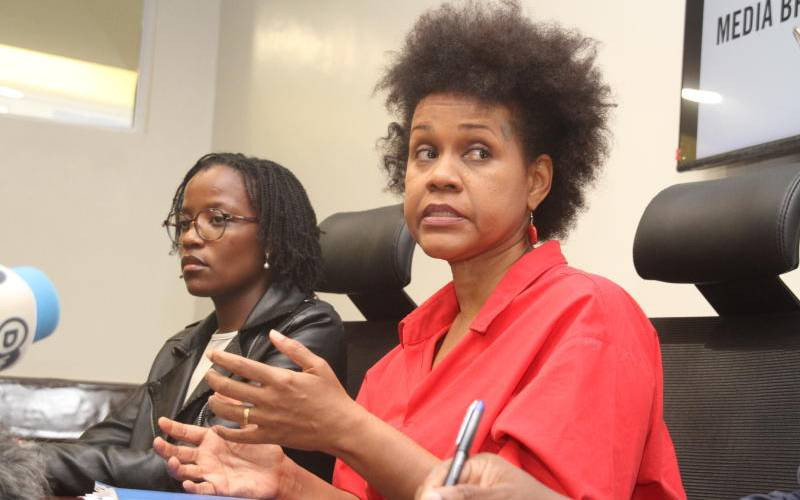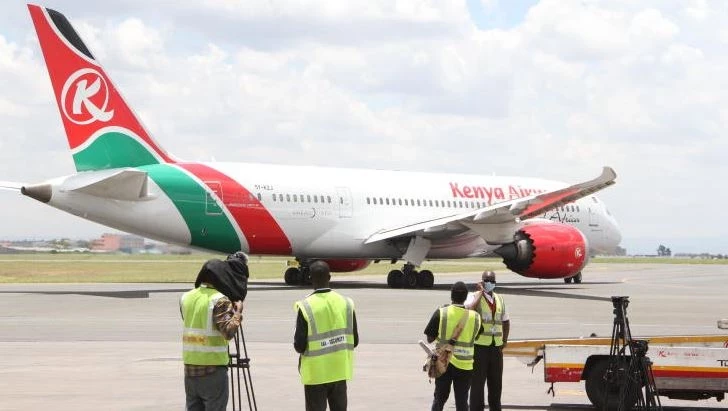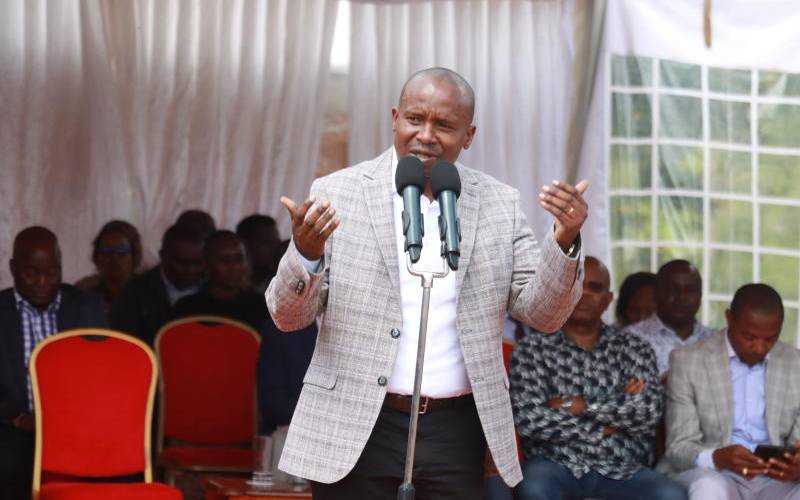 |
|
Jambojet takes the sky (Photo:Courtesy) |
By Emmanuel Were and Jevans Nyabiage
Nairobi, Kenya: In the late 60s, Rollin King and Herb Kelleher started a revolution in air transport.
While meeting over coffee, King, then the owner of a small Texan air commuter service, and the lawyer Kelleher came up with an idea that would change the airline landscape worldwide.
Their talk resulted in the creation of Air Southwest in 1967, a small inter-state airline. The airline was rebranded to Southwest Airlines and launched its inaugural flight on June 18, 1971.
Then, travelling on Southwest was fashionable and trendy. Its air hostesses wore orange hot pants (tight shorts worn by women) and white go-go boots (low-heeled women’s boots that go just below the knee), something that was later replicated around the world.
Take for instance this television advertisement in 1972: “Remember what it was like before Southwest Airlines? You didn’t have hostesses in hot pants.”
Southwest Airlines pioneered ways of reducing operating costs that are now used all over the world.
Lean operations
To cut costs, Southwest increased the number of seats and made sure each flight was full. It also flew its aircraft more often than full-service airlines.
With its lean operations and low fares of about $20 between neighbouring States, it won over thousands of new customers.
This low-cost concept would later help the Irish airline, Ryanair turn a profit after making losses of $20 million.
In the UK, easyJet’s no-frills model has been a hit.
In the East African region, FastJet, which is affiliated to easyJet, launched in Tanzania. The airline has plans to enter Kenya.
FastJet, backed by easyJet’s founder Stelios Haji-Ioannou, flies the Dar-es-Salaam route and became the third low-cost airline to operate international services within Africa.
It joined sister firm Fly540 and South African Airways’ subsidiary Mango.
Stay informed. Subscribe to our newsletter
And 43 years since Southwest Airline’s first flight, Kenya this morning witnessed the inaugural flight of Jambojet, a low-cost airline owned by national carrier Kenya Airways.
Jambojet Chief Executive Officer Willem Hondius says the airline will have 62 flights a week. These will be broken down as five-to-six times a day to Mombasa, twice a day to Kisumu and 10 times a week to Eldoret. The airline will start with three aircraft, all B737 Classics, owned by KQ.
“For the first eight months, we will fly within Kenya, and then from next year, we will add regional countries,” said Mr Hondius.
“For this concept we can only fly a maximum of four hours and draw a circle around it, such as Zanzibar, Kilimanjaro, Entebbe, Kigali and Addis Ababa.”
Score cheap tickets
For those who booked a month ago, a ticket one way to Mombasa, Eldoret or Kisumu was as cheap as Sh2,850.
But if you are the last-minute type, you will probably pay as much as Sh7,850 one way to Mombasa or Kisumu.
Strangely, however, the fare keeps on fluctuating.
For instance, on Tuesday, March 25, Business Beat booked a round trip from Nairobi to Mombasa and back, and it cost Sh15,700 — a bit more than the Sh15,175 Kenya Airways charged for the same journey.
But on Saturday, March 28, the same ticket cost Sh9,700.
Both times, the departure date was today, April 1, with a return date of Friday, April 4.
“When you choose a popular route on a popular day, the trick is to book early; don’t wait until a week before you need to leave. Unfortunately, Kenyan people have a tendency to wait until the last minute,” said Hondius in an interview last week.
Airline ticket pricing is a complex process driven by a lot of mathematics.
These companies are in the primary business of selling seats on a trip between two destinations. This is just like your typical matatu that gets you from point A to B.
The airlines must make sure they have enough seats to sell — but not too many or too few — between destinations.
Once they have figured out the right balance, they must make sure they price their seats correctly to cover all their costs, which include fuel, salaries and maintenance.
A lot goes into a plane ticket, such as taxes, airport costs, operating costs, seat selection, baggage and administration fees.
There are also considerations of class, competition on a route, destination, flight date and time, types of passengers, purchase date, and seat supply versus demand.
For an airline like KQ, it needs to make sure that the pricing will cater for any fluctuations in exchange rates since most of its costs are in dollars.
A low-cost carrier has fewer costs because it does not serve food or provide entertainment. However, not all its seats are priced at the cheapest rate.
In the case of Jambojet, only a limited number of seats will be priced at the minimum Sh2,850, and these will go to the early birds who pay a month or even two in advance.
Jambojet benefits in two ways from this.
First, the airline gets cash upfront, which is good news for any business person as it helps ease cash flow.
Second, as the date of departure nears, the airline can start working out how much to charge those rushing to book a seat at the last minute. The latecomers will be charged a premium that could price a ticket price as high as three times more than what those who booked early paid.
In such cases, the airline has the upper hand because it knows how many seats are available. The passenger, who does not have this information, is desperate to get to his or her destination and is, therefore, willing to pay whatever price the airline quotes.
PERCEPTION OF VALUE
This is the same mentality that matatu and bus crews deploy when they hike fares during the holiday season or when it rains during peak hours.
It means an airline, like most players in the service industry — which includes hotels, restaurants and supermarkets — has different prices based on customers’ perceptions of value.
Hondius says he has cut most of Jambojet’s costs to sustain the model and bring a profit.
“I’m very strict with cost control and my employees know this,” he said.
The firm is starting with 25 employees, most in administration and marketing. It has outsourced cabin staff to a third party, Career Directions.
“The cabin crew is not on our payroll, but they are trained by Kenya Airways at Pride Centre,” said Hondius, in what is seen as a move to beat the common labour troubles in the aviation business.
“I have been working with Kenya Airways since 1995, so I have had the training on these issues.”
Jambojet has also outsourced catering services to NAS, an on-site airport catering company.
To benefit from the Sh2,850 rate, Kenyans will need to learn to avoid the last-minute
happens, the carrier would have the carte blanche to increase fares.
Jambojet, however, said the low fares were core to its strategy.
“Low fares are here to stay … the idea is to try and grow the market by attracting new people,” said Mr Willem Hondius, Jambojet’s chief executive.
While a win for Jambojet would translate to a win for Kenya Airways, which wholly owns Jambojet, the two would also be in competition of sorts.
With KQ’s one-way tickets going for upwards of Sh10,000 on some of the routes Jambojet will fly, the national carrier might find it difficult to retain some of its domestic flights. It has already opted out of Nairobi-Eldoret route.
Catering companies
However, Mr Titus Naikuni, the chief executive of Kenya Airways, said the airline would continue to operate domestic flights, especially to Mombasa.
“We still have to connect our passengers on international flights that might be flying to Mombasa through Nairobi. We are not planning to cancel all the routes, only the ones that we believe serve the local sector. Jambojet is targeting a different clientele, some of whom may have never flown before, or those that mostly use buses,” he said.
The no-frills nature of the carrier means that it will just give passengers a seat and belt on board its planes, and they will have to buy everything else.
There are concerns that the likely loser in this scenario would be the companies that make meals for airlines.
Mr Hondius said Jambojet has contracted NAS to prepare food, snacks and drinks that will be sold on its flights.
In Kenya, NAS prepares the meals served to airline passengers, but it now faces competition from Lufthansa’s LSG Sky Chefs, which recently won a tender to operate a second in-flight catering unit at the Jomo Kenyatta International Airport.
But Jambojet offers both a win and lose scenario for catering companies.
It might be a loss for the firms because the airline will not pay for food for their passengers. Instead, the companies will be reduced to more or less “hawking” their meals and drinks inside the aircraft, hoping passengers will feel sufficiently hungry during the short ride to domestic destinations to make a purchase.
The upside to this for NAS is that passengers may buy more food than an airline would normally provide.
Labour relations
The airline has also outsourced cabin crew management to human resource consultancy firm Career Directions Ltd (CDL). By contracting CDL to provide cabin crew as and when needed, Jambojet might be able to avoid the labour relations minefields that have proved costly to its parent firm in the past. CDL has also previously provided staff for KQ.
Hondius said the crew that have been recruited by CDL had been trained by KQ.
But let us not forget that on the same day that Jambojet makes its maiden trip, new rules aimed at bringing sanity to the matatu industry will be effected.
Matatus and buses have been the only means of transport affordable for many Kenyans travelling between towns.
Under the new rules, matatus are to be run by Saccos, their owners will have to pay drivers a basic monthly salary, and long-distance owners will need to have a fleet management system that records and stores data on vehicle speeds and location.
It is too soon to tell if these rules will be effective in making road travel more comfortable, cheaper and safer. But the rules come at a time when Kenya is embarking on infrastructure spending aimed at building wider and better roads that will ease travel.
However, the airline offers the extra advantage of cutting the eight hours it would take to reach Mombasa by bus to one hour. It will take 50 minutes to get to Mombasa or Eldoret.
Alternatives
Matatus and bus companies may be relegated to offering a connecting link for passengers travelling to towns not serviced by airline carriers.
For example, a person travelling to the border town of Busia might opt to fly to Kisumu, then use public means to get to Busia.
There is also debate on how the standard gauge railway line could drastically change travel between Nairobi and some of the towns in Rift Valley like Nakuru and Naivasha.
While an airline like Jambojet might not serve these towns, the railway line provides a faster and cheaper alternative compared to road transport.
Further, if the high-speed railway line becomes a reality, it might end up disrupting the low-cost carrier model, not only for Jambojet, but also for other players in the market.
 The Standard Group Plc is a
multi-media organization with investments in media platforms spanning newspaper
print operations, television, radio broadcasting, digital and online services. The
Standard Group is recognized as a leading multi-media house in Kenya with a key
influence in matters of national and international interest.
The Standard Group Plc is a
multi-media organization with investments in media platforms spanning newspaper
print operations, television, radio broadcasting, digital and online services. The
Standard Group is recognized as a leading multi-media house in Kenya with a key
influence in matters of national and international interest.
 The Standard Group Plc is a
multi-media organization with investments in media platforms spanning newspaper
print operations, television, radio broadcasting, digital and online services. The
Standard Group is recognized as a leading multi-media house in Kenya with a key
influence in matters of national and international interest.
The Standard Group Plc is a
multi-media organization with investments in media platforms spanning newspaper
print operations, television, radio broadcasting, digital and online services. The
Standard Group is recognized as a leading multi-media house in Kenya with a key
influence in matters of national and international interest.










